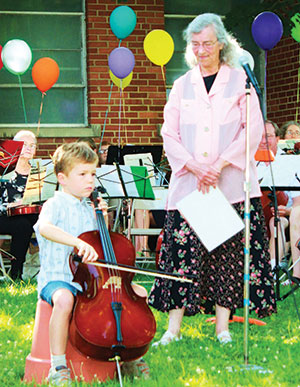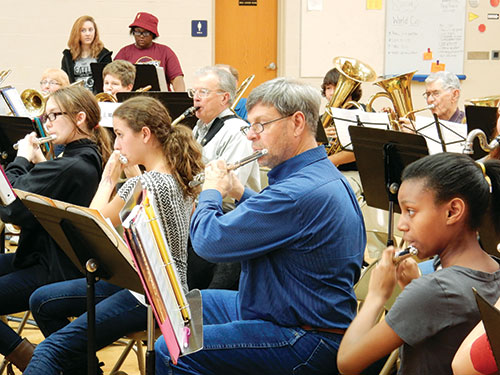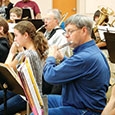During my school years it was easy to get out of doing dishes after supper. Fortunately, Mom enjoyed hearing the rest of us playing pop music selections with Dad on trumpet, my brother on trombone, and me on piano. As a high school and college student I performed in the local community band and chorus. Audiences might have noticed the wide variety of ages among the participants, but I thought nothing of it. I did not know that these experiences would inspire multi-generational music making opportunities throughout my teaching career.
Broadening the base of music lovers and music supporters will naturally garner support for a school music program. We are excited to share reliable, tested, and fresh concepts for generating support to create a strong school music program in which you and your students can thrive. Specifically, we will focus on intergenerational activities to expand the base of support.
Building a Community Network
While we have both immersed ourselves with intergenerational music making, we learned early on that these experiences could directly lead to multiple benefits for our local school music programs. We continue to teach and perform with multiple generations because we enjoy it. However as former public school music teachers, we are keenly aware of the struggles to build financial support for a music program. Using music activities with participants of various ages can be fundamental to enriching educational opportunities for students.
Becoming an active and visible musician in your community is a terrific place to begin. You will find yourself performing next to musicians from all ages and professional backgrounds. These are opportunities to share your expertise as a musician and your excitement about the school music program. In turn, you will learn more about the community, local leaders, families with musical backgrounds and passions, and businesses that may be interested in sponsoring special events, scholarships, and even travel.
Creating musical events that will attract the community is also imperative for building support for school music programs. Intergenerational concerts tend to attract a wide spectrum of people and create indispensable connections with the public.
Getting Started
Take an inventory of community music groups in your school district. You may be surprised. Your community need not be large to generate multiple music opportunities. Yellow Springs, Ohio (Shirley’s hometown), population 3680, supports a community band, chorus, chamber orchestra, Yellow Springs Strings, several chamber groups, Springs Chamber Players, World House Choir, and a Slovakian Women’s Chorus. The village also has a popular five-concert premier Chamber Music Series; a local business sponsors live music every Friday night for wine tasting events. On weekends, amateur musicians can often be found at local storefronts and restaurants. There may be plenty of adults with desire and talent to play in music groups. A trailblazer like you is all that is needed to help organize music ensembles in your area.
After identifying the various community ensembles, begin creating opportunities to connect. Some school music programs regularly invite community members to join daily rehearsals. Many retirees seek scheduled activities to stay active and engaged. In addition to rehearsing with school ensembles, many able volunteers might share their expertise and assistance through administrative work or even instruction.
Shirley Strohm Mullins Reflects
At the Celebration of Life service for my late husband, Bill, our friend Gilah told this story. It was news to me and probably to most of the audience. Gilah noted that Bill played trumpet in high school and college and liked being in a band. If Bill could recruit enough players, the school band director said he would conduct them. Gilah was Bill’s first attempt, and he had no intention of failing. He cornered her in the village on a Saturday morning. The conversation went like this:
“Hi Gilah. I heard that you used to play bass clarinet.”
Gilah replied, “Oh, yeah. I used to play in the high school band years ago.”
Bill said, “Well, we’re forming a community band, and we really need a bass clarinet player. How about it? Still have your instrument?”
“Yeah,” answered Gilah. “I have it somewhere – probably in a closet.”
“Great! We’re meeting in the high school music room next Monday at 7:00pm. Thanks, see you there!”
Gilah responded, “But I— My reeds are—”
By then Bill was down the street talking to an old buddy who used to play the baritone and was giving him the speech.
Gilah continued, “I showed up Monday night and saw several friends who had played in our high school band. We all looked scared silly, but we did okay and it was fun. Now, our band is one of the great joys of my life, all because Bill wouldn’t take no for an answer.”
To honor his vision and persistence, Gilah asked some of the band members to show up early to Bill’s service so that they could play The Stars and Stripes Forever one more time, just for him.
Concerts featuring several generations can be particularly memorable and rewarding for all involved. Start by surveying your students to discover family members who sing or play an instrument. Creating a concert to feature a combined selection with family members will generate community support and increase your audience. If some family members no longer have their instruments, local music dealers are often willing to assist. One or two rehearsals before the concert should be enough; a perfect performance is not the goal. However, this enjoyable opportunity will have a lasting effect.
Finding Opportunities
If you live near a college, this may open opportunities to share rehearsals or concerts. Again, one or two rehearsals can easily achieve the desired result. Some examples include performing the national anthem at a university sporting events, collaborating on a concert or halftime show, or inviting a university professor as a guest soloist or conductor.
In 1991, a unique concept of music education was created with a focus on adults. Founded at the Eastman School of Music under Roy Ernst’s innovative leadership, there are now over 200 New Horizons Music programs in the country. These programs offer the opportunity for adults to join a band, orchestra, or choir with a focus on beginning-level or reentry-level music making. Unlike most established community music ensembles, the New Horizons Music repertoire often mirrors the level of school music programs with beginning, intermediate, and advanced levels, with the unique focus on instruction as well as social connections. Through joint events and relationships built over time, New Horizons Music programs can have an enormous effect with community support for your school music program. You can discover if there is a New Horizons program near you at www.newhorizonsmusic.org. This website also provides information and support for starting a New Horizons Music program.
For all events with a wide age range, we recommend developing seating arrangements and social events to encourage players to mingle. Conversations that arise can be priceless and powerful, and they will likely enhance the musical and educational experience. Planning time for socializing is a key for all participants, including audience members. You may find that immediately following an exciting concert is a prime time to recruit new members and request support.
Shirley Strohm Mullins Reflects
Our most recent concert included the adult orchestra and the children’s orchestra. We played together on some pieces, and the senior orchestra played two selections alone with a handful of advanced youngsters. It is important that the repertoire is well chosen; the adults often prefer quiet, melodic pieces while the younger players love loud and fast selections.
The concert was limited to 45 minutes – short enough for the little ones in the audience and long enough for the musicians to show their stuff. The reception afterwards is another thing altogether, without a designated ending. The musicians visited with each other, discussing topics far removed from music. “Do you like arithmetic?” a student asks his stand partner. “Oh yes,” says the retired mathematics teacher, with a broad smile. “Love it! It’s so interesting.” Refreshments add to the overall joyous atmosphere. “We really sounded good, didn’t we?” a child asked his stand partner, a professor of physics at a nearby university. “I’ll say. We sounded magnificent,” was the response, while sharing high fives all around. “When is our next concert? This was so much fun. Will you be here next year? Can we sit together again?”
This amazing concert was inexpensive to produce and involved families with publicity and printed programs, stage set-up and tear-down, refreshments, and many other tasks. We all know that when parents are enthusiastically engaged, students practice more and take pride in their accomplishments. The end result benefits everyone involved.

An intergenerational performance at the concert celebrating the 50th anniversary of the student orchestra program in Yellow Springs, Ohio.
Funding Sources
Our profession relies heavily on the ability to raise funds for school music programs. Some music teachers are successful at motivating students to sell magazines, coupon books, candy, fruit, and calendars. However, there are alternative means to build support for school music programs that more closely relate to music education and the expertise of the music teacher. Creating a community of support is essential and can lead to sought-after as well as unexpected financial support.
A quick look at the Inside Philanthropy website for K-12 funders reveals some encouraging news: “Historically, secondary and elementary education has been the second-most funded education cause, just after colleges and universities. . . . The bottom line: There are funders for just about every type of K-12 project.” (www.insidephilanthropy.com/
If your school district uses a grant writer, or if you can make time for grant writing, you may find great satisfaction in bringing new opportunities to your school district. Likely there is someone in your community with grant expertise who could work with you in exploring grant opportunities and take on the responsibilities of writing, submitting, and securing funding.
Grants of all sizes can jumpstart initiatives, bringing new life and recognition to existing programs. Perhaps there are alumni from your program who could return to be featured with your ensemble. Commissioning a new work for an alumni soloist or composer could also be supported by a grant. Possibly a special piece of equipment could be purchased that would make it possible for program growth. A grant could fund a multi-generational event by providing the money to rent the local performing arts center, supply refreshments for a reception, or market the event. Whatever the goal, seeking grant opportunities has its rewards.
An additional financial resource to explore is an endowment fund or foundation fund for recognition and sustainability. Your school or community may have guidelines on establishing an endowment or foundation. These funds can be seen as safe and secure investments to ensure specific expenditures, such as scholarships, or to supplement fiscal operating budgets. The larger the endowment, the more interest is generated. You might be surprised to know the number of community members willing to support your program and looking for tax deductions. Additionally, legacy giving can be used to support endowments, which can be attractive to the older adult population.
After building a culture of community interest, you will likely find parents, grandparents, local businesses, and other community members asking how they can help their local school music program. Grants and donations are generally used for special projects or events but might not provide ongoing support.

Shirley Strohm Mullins Reflects
On a day in mid-November, the mail arrived with its usual multitude request for donations. But there at the bottom of the pile was a handwritten envelope. In it was a note thanking the Yellow Springs Youth Orchestra for bringing music into their family’s lives. This note was accompanied by a check made out to the Yellow Springs Youth Orchestra – a 501(c)(3) organization. People do want to help us. We just need to show them how.





